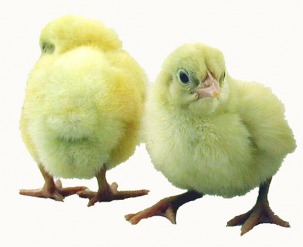For the past year and a half we've called our homestead "The Wagar Family Farm" yet we've not raised any type of livestock. Don't get me wrong, we've been working very hard at getting our ducks in a row (no pun intended) in order to allow us to begin our dream of becoming semi-self-sufficient.
Well, the time has come, as of today, and arriving on or around the 19th of May, the Wagar Family Farm will be raising a flock (25) White Rock chickens. I purchased these chicks online (as if I shop anywhere else) at Murray McMurray Hatchery, a premier chicken and game foul hatchery located in Webster City, Iowa. Per their website here is a short description of the White Rock Hens:
"White Rock pullets are outstanding for egg production the entire year, and are especially desirable through the cold winter months when lighter breeds slack off. They lay a brown egg of fine quality and size. The rapid growth, white, easy-to- dress feathers, and golden yellow skin of the cockerels of our strain make them equally desirable. Raise some for the frying pan or roaster. They are compact and well fleshed at almost any age. They are all big birds, hens reaching 6 to 7 lbs. and cocks 8 to 9 lbs. A flock of these pure white birds ranging busily over a grassy field is one of the prettiest sights you will ever see. Baby chicks are a creamy white and may show a touch of gray smokiness."
For those of you that are unfamiliar with how raising chickens works here is a quick overview:
Week 1-5:
Chicks arrive and are corralled indoors under a heat lamp with plenty of water and food available to them.
Week 6-24
The chickens are now ready to be placed out on pasture. I will be blogging about a new mobile chicken coop that I will be building in the later weeks. This coop will be surrounded by a mobile electric fence which will help to keep the predators out (i.e. coyotes, dogs, cats, etc). As the names suggest all of these items are mobile so that we can move them around our property as needed. They will continue to feed and roost in the coop, however no eggs will likely be produced.
Week 25- 104
The chickens should now begin to lay superb brown eggs for the family to enjoy. On average starting between weeks 25 and 30 we should begin to received on average 1 egg per chicken per day. Based on many factors (food, light, heat, water, etc) this should continue for about 2 years at which point the egg production typically drops off and most of the birds (unless they are still producing high quality eggs) will become chicken soup or stew meat, as they are no longer at the quality needed for grilling etc.
What does this all mean?
By Christmas of 2008, the Wagar family should be one step closer to becoming self-sufficient by no longer needing to purchase eggs from either the grocery store or other local farmers. In addition, each year after we will plan to purchase an additional 25 chicks allowing for an endless supply of farm fresh eggs, and although we eat a lot of eggs, we should be able to begin selling to other local families who are looking to purchase a superior product, compared to grocery stores, for their families.
For more information on large-scale hatcheries, watch the video below.
What an interesting process seeing chicks born at the hatchery! Those little fellows sure go through a lot to become our dinner!
I enjoyed looking at your website. I'm your second cousin, Keith, living outside Phx., AZ. I'm daughter to your mom's cousin, Roger Stocksdale. My husband and I have 3 kids and have been homeschooling for the last 5 years. We love it! We don't have any chickens or goats...but you never know! : ) Right now, we're just trying to get our garden growing.
God bless you as you enjoy teaching and training your kids in His ways...
Kim
